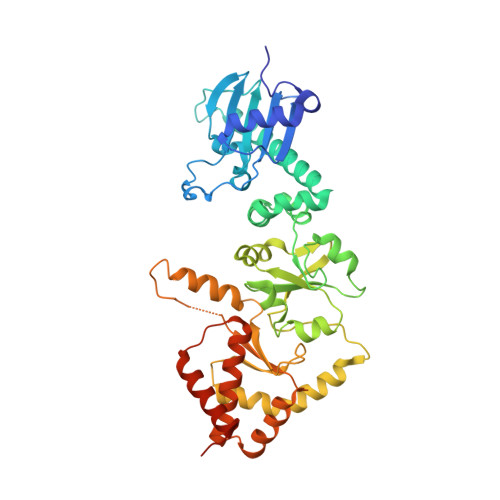Crystal structure of the middle and C-terminal domains of Hsp90 alpha labeled with a coumarin derivative reveals a potential allosteric binding site as a drug target.
Peng, S., Woodruff, J., Pathak, P.K., Matts, R.L., Deng, J.(2022) Acta Crystallogr D Struct Biol 78: 571-585
- PubMed: 35503206
- DOI: https://doi.org/10.1107/S2059798322002261
- Primary Citation of Related Structures:
7RY1 - PubMed Abstract:
The 90 kDa heat-shock protein (Hsp90) is an abundant molecular chaperone that is essential to activate, stabilize and regulate the function of a plethora of client proteins. As drug targets for the treatment of cancer and neurodegenerative diseases, Hsp90 inhibitors that bind to the N-terminal ATP-binding site of Hsp90 have shown disappointing efficacy in clinical trials. Thus, allosteric regulation of the function of Hsp90 by compounds that interact with its middle and C-terminal (MC) domains is now being pursued as a mechanism to inhibit the ATPase activity and client protein-binding activity of Hsp90 without concomitant induction of the heat-shock response. Here, the crystal structure of the Hsp90αMC protein covalently linked to a coumarin derivative, MDCC {7-diethylamino-3-[N-(2-maleimidoethyl)carbamoyl]coumarin}, which is located in a hydrophobic pocket that is formed at the Hsp90αMC hexamer interface, is reported. MDCC binding leads to the hexamerization of Hsp90, and the stabilization and conformational changes of three loops that are critical for its function. A fluorescence competition assay demonstrated that other characterized coumarin and isoflavone-containing Hsp90 inhibitors compete with MDCC binding, suggesting that they could bind at a common site or that they might allosterically alter the structure of the MDCC binding site. This study provides insights into the mechanism by which the coumarin class of allosteric inhibitors potentially disrupt the function of Hsp90 by regulating its oligomerization and the burial of interaction sites involved in the ATP-dependent folding of Hsp90 clients. The hydrophobic binding pocket characterized here will provide new structural information for future drug design.
- Department of Biochemistry and Molecular Biology, Oklahoma State University, 246 Noble Research Center, Stillwater, OK 74078, USA.
Organizational Affiliation:

















